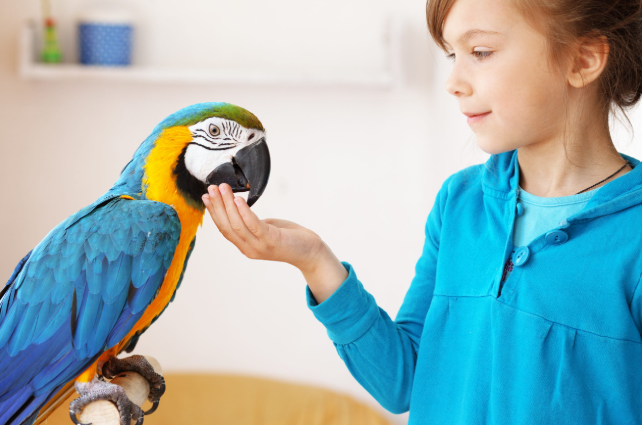Parrots are famous for their ability to mimic human speech, but not all parrots naturally start talking. Teaching your feathered friend to speak takes patience, consistency, and the right approach. In this guide, we’ll walk you through step-by-step methods to encourage speech in your parrot.
1. Choose the Right Parrot Breed
Some parrot species are more talkative than others. While all parrots have the ability to mimic sounds, the following species are known for being great talkers:
- African Grey Parrot – One of the best talkers, known for a vast vocabulary and understanding of context.
- Amazon Parrots – Loud, clear talkers with excellent memory.
- Indian Ringneck Parrots – Great mimics that can develop a large vocabulary.
- Budgies (Parakeets) – Small but mighty, budgies can learn many words with practice.
- Quaker Parrots – Social birds that enjoy mimicking sounds and phrases.
2. Start with Simple Words
Begin with easy, frequently used words like:
- Hello
- Good morning
- Bye-bye
- Pretty bird
- Your parrot’s name
Repeat these words daily in a clear, enthusiastic tone.
3. Use Repetition and Consistency
Parrots learn through repetition, so say the chosen words often, preferably at the same time each day. For example:
- Greet your parrot with “Good morning!” every day.
- Say “Bye-bye” when leaving the room.
- Offer treats and say “Yummy!” during feeding time.
4. Speak with Enthusiasm
Parrots are more likely to mimic sounds that excite them. Use a happy, expressive voice when speaking. High-pitched or animated tones tend to capture their attention best.
5. Reward with Positive Reinforcement
Whenever your parrot attempts to mimic a word, reward them with:
- A treat (fruit, nuts, or a favorite snack)
- Affection (gentle head scratches)
- Excited praise (“Good job! What a smart bird!”)
This reinforces the behavior and encourages them to try again.
6. Play Recordings or Use a Talking Parrot Toy
If you’re not around all day to repeat words, consider playing recordings of common phrases. You can:
- Record yourself saying words and play them on repeat.
- Use a talking parrot toy that repeats phrases.
- Play YouTube videos of talking parrots to inspire yours.
7. Talk During Everyday Activities
Integrate speech training into your daily routine. For example:
- When feeding, say “Eat your food!”
- While cleaning their cage, say “Clean up!”
- Before bedtime, say “Good night!”
This helps your parrot associate words with actions.
8. Be Patient and Avoid Negative Reactions
Not all parrots learn at the same pace. Some take weeks, while others may take months to say their first word. Avoid:
- Getting frustrated if your parrot isn’t talking yet.
- Yelling or reacting negatively, as this can discourage learning.
- Teaching inappropriate words (parrots love repeating things they hear often!).
9. Socialize and Encourage Interaction
Parrots learn best in engaging environments. Try:
- Talking to your parrot regularly throughout the day.
- Letting them hear conversations between family members.
- Encouraging interactions with other talking birds (if possible).
10. Expand Their Vocabulary Gradually
Once your parrot masters a few words, introduce new phrases like:
- “How are you?”
- “What are you doing?”
- “I love you!”
You can also teach them fun phrases associated with actions, like “Give me a kiss!” followed by a kiss sound.
Final Thoughts
Teaching your parrot to talk is a rewarding experience that strengthens your bond. With patience, repetition, and positive reinforcement, your parrot can develop an impressive vocabulary over time. Start small, be consistent, and most importantly—have fun with the process!
Has your parrot learned any words? Share your experiences in the comments below!



